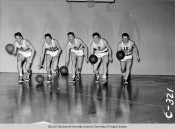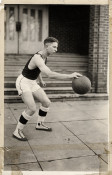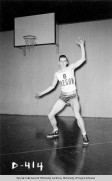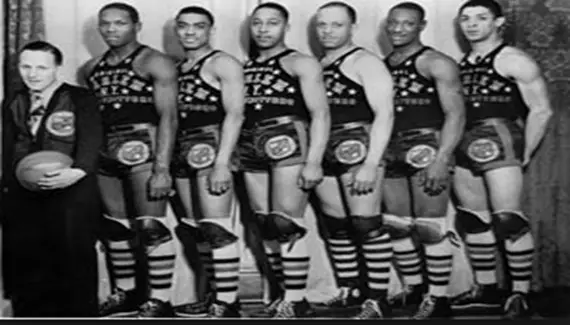What were a person’s entertainment choices in Eugene on a Tuesday night in February, 1943? It was the height of World War II and choices were limited. You could go dining and dancing at The Holland, go ice skating, or catch a double feature at one of the area theaters.
There was one other option on February 1st. You could purchase a ticket for a basketball game between the Oregon Ducks and the Harlem Globetrotters at Mac Court, or as it was referred to in those days, the Igloo. Yes, the Ducks actually played a game against the Globetrotters, although the local media referred to them as the “Casaba Tricksters.”
The Globetrotters got their start in 1926 in Chicago as the Savoy Big Five, an advertising ploy by the Savoy Ballroom. Abe Saperstein was the founder, coach and occasional player when the team was short-handed. One of the early members of the team was Joe Lillard. Some might recall that he was once a Webfoot football player. Lillard played for the freshmen in 1930, and the varsity for two games in 1931 before his eligibility was challenged as a result of playing baseball in the Negro Leagues.

Don Kirsch, Bob Wren, and Rolph Fuhrman
Courtesy University of Oregon Libraries- Special Collections and Digital Archives
The Savoy Big Five would eventually become the Harlem Globetrotters, despite the fact that they did not play a game in Harlem until 1968. In 1940, the Globetrotters won the world professional championship against the George Halas-owned Chicago Bruins.
There was no NBA in 1940, so the following year, the Globetrotters signed Reese “Goose” Tatum, a future Hall-of-Fame member, who became the first “Clown Prince” of the team. It was Tatum, a multi-sport star, who introduced many of the comedic routines that the Globetrotters became famous for. He is also credited with inventing the hook shot.
By the time the Globetrotters made it to Eugene, they had achieved a record 2,163 wins and 162 losses, with most of the losses coming in the early years of the team. They were a definite favorite over the young war-time Ducks. Ticket sales were brisk, and an estimated crowd of 4,500 entered the Igloo to be entertained.
Fans were no doubt impressed by the fancy ball-handling of the Globetrotters in pre-game warm-ups. However, once the whistle blew the Globetrotters had to play by the same rules as the Ducks.

Howard Hobson – Coach
Courtesy University of Oregon Libraries – Special Collection and Digital Archives
Oregon’s legendary basketball and baseball coach, Howard Hobson, elected to play all 15 players on his roster. What Hobson did was split the team into three distinct units, which rotated by quarter during the game.
The first unit consisted of the usual starters, Roger Wiley at center, Ed Dick and Rolph Fuhrman at forwards, and Stan Williamson and Don Kirsh at guards. Kirsh is probably best known for playing and coaching baseball for Oregon.
A second unit was made up of 6’8 Wally Borrevik at center, forwards Warren Taylor and Roy Seeborg, and guards Al Popick and Sammy Crowell. The third squad consisted of Warren Christensen and Bob Wren at forward, Walt Reynolds and Bob Newland at guard and Dennis Sutherland at center.
The Globetrotters countered with only six players: Tatum and Henry Singleton at forward, Big Bob Powell at center, and Everett Marcell and Roscoe Julien at guard. John Jackson, a forward, was the only substitute.
Oregon came out fast and jumped into the lead. By the third quarter Oregon was up 35-21, but Harlem managed to close the gap to 47-42 late in the fourth quarter. However, a couple of key buckets by the Ducks gave them a 51-44 victory over the Globetrotters, much to the delight and amazement of fans. Wiley led the Ducks in scoring with eight points.

Roger Wiley – Center
Courtesy University of Oregon Libraries – Special Collections and digital Archives
The Ducks went on to finish the season with a decent 19-10 record. Tatum left the Globetrotters later in the season for the Army Air Corps.
Saperstein then signed Bob Karstens, the first white player to play with the Globetrotters. Karstens is credited with creating the “Magic Circle” routine used by the Globetrotters.
___________________________
This game was the only time the Oregon Ducks played the Globetrotters, but in a war-weary world in 1943, it undoubtedly served to boost the morale of Duck fans.
Top Photo from harlemglobetrotters.com
Related Articles:
Jim currently resides in Ellensburg, Washington where he has had the opportunity to watch former Ducks such as NaDerris Ward and Scott Grady play for Central Washington University, Jim’s alma mater. However, Jim was born in Eugene and attended Howard Elementary School, and what then called Colin Kelly Junior High School before moving to Washington. Jim began following the Ducks during the 1957 season and had the opportunity to watch a number of games at Hayward Field. Over the years, Jim has developed a wealth of knowledge about Oregon sports history. When not editing on Fanbase.com or working in his garden, Jim manages to find time to practice law.

